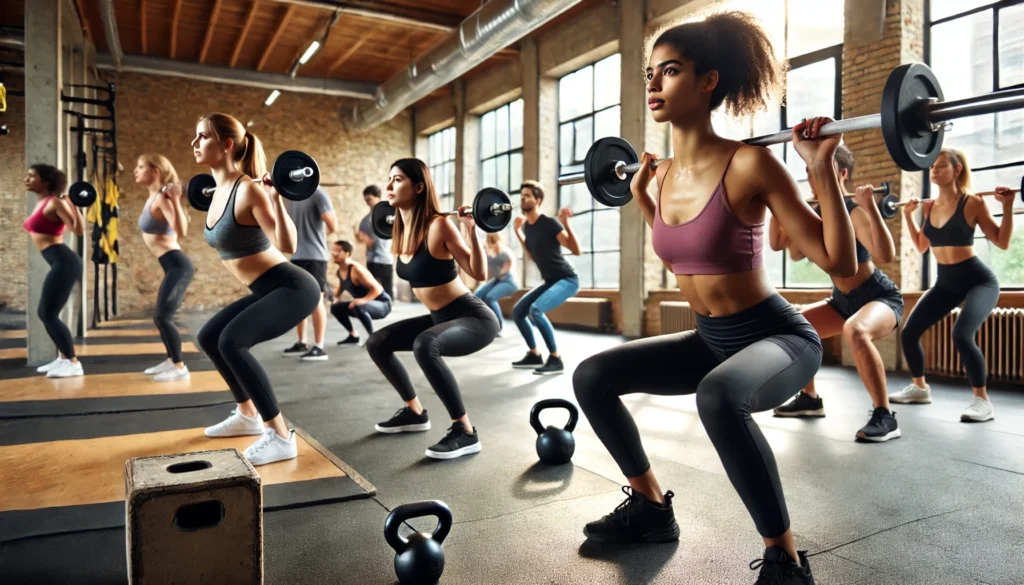Introduction: The Importance of Strength Training for Women
Strength training is often overlooked by women due to misconceptions about developing excessive muscle mass. However, strength exercises for women offer numerous benefits, including improved metabolism, enhanced bone density, and increased muscle tone. Resistance training exercises for women are essential in preventing osteoporosis, reducing the risk of injury, and enhancing overall functional strength. Unlike traditional cardio workouts, strength training builds lean muscle while increasing endurance and promoting long-term fat loss. By incorporating a structured training regimen, women can achieve balanced fitness, functional movement, and an overall healthier lifestyle.
You may also like: The Ultimate Bodyweight Workout Routine for Full-Body Strength and Performance
The Science Behind Strength Training for Women
Women naturally have lower levels of testosterone than men, making it difficult to gain large amounts of muscle mass. However, this does not mean that strength training is ineffective for achieving muscle tone and endurance. Strengthening exercises for women rely on the principle of progressive overload, where muscles adapt to increasing levels of resistance. Whether through weight training at home for ladies or resistance bands, challenging the muscles leads to improved strength, endurance, and muscle definition. Engaging in consistent training also stimulates the release of growth hormones, which aid in muscle recovery and fat metabolism.
Benefits of Strength Exercises for Women
- Improved Muscle Tone: Strength training helps define and shape the muscles without excessive bulk, leading to a leaner physique.
- Enhanced Bone Density: Resistance training exercises for women reduce the risk of osteoporosis by strengthening bones and joints.
- Increased Metabolism: More muscle mass leads to higher resting energy expenditure, helping with long-term weight management.
- Functional Strength: Lifting weights and bodyweight exercises improve day-to-day activities such as lifting, bending, and carrying.
- Mental Health Benefits: Strength training has been shown to reduce stress, anxiety, and symptoms of depression, leading to improved mental well-being.
Essential Strengthening Exercises for Women
- Squats: An effective lower-body exercise that builds strength in the glutes, quads, and hamstrings.
- Push-Ups: A fundamental upper-body movement that targets the chest, shoulders, and triceps.
- Lunges: Great for improving balance and strengthening the legs and core.
- Planks: Strengthens the core, stabilizing the body for better posture and injury prevention.
- Deadlifts: When done with dumbbells or resistance bands, deadlifts strengthen the posterior chain, including the lower back and hamstrings.
Weight Training at Home for Ladies: A Practical Approach
Many women assume that they need access to a gym for strength training, but effective workouts can be performed at home with minimal equipment. Weight training at home for ladies can include bodyweight exercises, dumbbell training, and resistance bands. Compound movements, such as squats and push-ups, are particularly effective in targeting multiple muscle groups simultaneously. Additionally, progressive overload can be achieved by increasing repetitions, adding resistance, or modifying exercises to increase difficulty. A structured home workout plan can deliver impressive results without the need for a gym membership.

Resistance Training Exercises for Women Without Weights
For those who do not have access to gym equipment, resistance training exercises for women can still be highly effective. Using resistance bands provides external tension to strengthen muscles similarly to free weights. Isometric exercises, such as wall sits and static holds, challenge endurance and muscular stability. Plyometric movements, such as jump squats and explosive push-ups, build power and enhance cardiovascular endurance. By combining various resistance methods, women can develop comprehensive strength and endurance without the need for traditional gym weights.
Strength Training Guidelines for Women
- Start with Proper Form: Proper execution of movements prevents injury and ensures maximum muscle activation.
- Focus on Compound Movements: Multi-joint exercises engage more muscles and provide a greater return on effort.
- Use Progressive Overload: Gradually increase resistance, duration, or repetitions to continue making gains.
- Prioritize Recovery: Rest days and active recovery methods like yoga and stretching prevent burnout and improve results.
- Maintain a Balanced Diet: Protein-rich foods, healthy fats, and complex carbohydrates fuel muscle growth and recovery.
Overcoming Common Barriers to Strength Training
Many women hesitate to incorporate strength training into their fitness routines due to common myths and misconceptions. Some fear that lifting weights will make them bulky, but in reality, resistance training helps sculpt lean and toned muscles. Others may struggle with a lack of motivation or uncertainty about where to start. Following a structured program and setting realistic goals can help establish consistency. Additionally, tracking progress through strength improvements and body composition changes can serve as powerful motivators. By breaking through these barriers, women can fully embrace the benefits of strength training.
Sample Strength Training Routine for Women
Day 1: Lower Body Focus
- Squats: 3 sets of 12 reps
- Lunges: 3 sets of 10 reps per leg
- Glute Bridges: 3 sets of 15 reps
- Calf Raises: 3 sets of 20 reps
Day 2: Upper Body & Core
- Push-Ups: 3 sets of 10 reps
- Dumbbell Shoulder Press: 3 sets of 12 reps
- Bicep Curls: 3 sets of 12 reps
- Plank Hold: 3 sets of 30 seconds
Day 3: Full-Body Conditioning
- Burpees: 3 sets of 10 reps
- Deadlifts (Dumbbells or Bands): 3 sets of 12 reps
- Side Lunges: 3 sets of 10 reps per leg
- Russian Twists: 3 sets of 15 reps per side

Frequently Asked Questions (FAQ) on Strength Exercises for Women
1. Why are strength exercises for women important for overall health?
Strength exercises for women contribute to increased muscle mass, improved metabolism, and enhanced bone density. Unlike the misconception that weight training leads to excessive bulk, strengthening exercises for women help in achieving a leaner, more toned physique. These exercises also aid in joint stability, reducing the risk of injuries and promoting better posture. Additionally, resistance training exercises for women play a crucial role in hormonal balance, benefiting overall well-being. Engaging in consistent strength training enhances longevity, cognitive function, and cardiovascular health.
2. How often should women engage in strength training exercises?
For optimal results, women should aim to engage in strength exercises for women at least three to four times a week. This frequency allows for proper muscle recovery while ensuring progressive improvement in strength and endurance. Weight training at home for ladies can be done on alternate days to prevent overtraining and muscle fatigue. Additionally, incorporating resistance training exercises for women with varied intensity levels ensures well-rounded development. The key to sustainability is consistency and gradually increasing the challenge to avoid plateaus.
3. What are the best strengthening exercises for women who are beginners?
Beginners should start with foundational movements that focus on multiple muscle groups, such as squats, lunges, and push-ups. These exercises improve strength and balance while preparing the body for more advanced workouts. Weight training at home for ladies can begin with resistance bands and light dumbbells to build confidence and technique. Engaging in bodyweight movements such as planks and step-ups can also enhance stability and endurance. Progressing to more complex resistance training exercises for women ensures continued strength gains without risking injury.
4. Can resistance training exercises for women help with weight loss?
Yes, resistance training exercises for women significantly contribute to weight loss by increasing muscle mass and boosting metabolic rate. Unlike cardio workouts, which burn calories only during the session, strength exercises for women create a prolonged calorie-burning effect. Weight training at home for ladies also helps in preserving lean muscle while losing fat, ensuring a sculpted appearance. Additionally, combining resistance training with a balanced diet enhances fat loss efficiency. Strength training also improves insulin sensitivity, aiding in better blood sugar regulation.
5. What is the best way to structure a home strength workout for women?
A well-balanced home strength workout for women should include lower-body, upper-body, and core exercises. A session can start with dynamic warm-ups, such as arm circles and leg swings, to prepare the muscles. Strengthening exercises for women should then focus on major muscle groups, incorporating movements like squats, push-ups, and resistance band exercises. Weight training at home for ladies should also include functional movements, such as deadlifts and step-ups, to enhance daily activity performance. Cooling down with stretches ensures flexibility and reduces post-workout soreness.
6. Are bodyweight exercises effective for building muscle in women?
Yes, bodyweight exercises are highly effective in building muscle, especially when combined with progressive overload techniques. Strengthening exercises for women that involve bodyweight movements, such as push-ups, planks, and dips, enhance muscular endurance and strength. Resistance training exercises for women can be intensified by increasing repetitions, incorporating time-under-tension techniques, or adding resistance bands. Weight training at home for ladies does not necessarily require gym equipment; simple variations and modifications can provide sufficient resistance. With consistency, bodyweight training leads to substantial strength gains and improved muscle definition.
7. How can women ensure they are progressing in their strength training?
Progression in strength exercises for women can be achieved by gradually increasing resistance, repetitions, or intensity. Keeping track of personal records, such as lifting heavier weights or performing more reps, helps in measuring improvement. Weight training at home for ladies can be advanced by incorporating resistance bands, heavier dumbbells, or bodyweight variations like single-leg squats. Another way to ensure progression is by reducing rest times between sets, challenging muscular endurance. Adapting workouts to personal fitness levels ensures consistent and sustainable strength gains.
8. Is weight training at home for ladies as effective as training in a gym?
Yes, weight training at home for ladies can be just as effective as gym workouts if structured correctly. With resistance bands, dumbbells, or household items, women can perform a variety of resistance training exercises for women targeting different muscle groups. Strength exercises for women performed at home should focus on compound movements like lunges and push-ups for full-body engagement. The key is consistency, progressive overload, and proper form to maximize results. Home workouts also offer flexibility and convenience, making them a sustainable fitness approach.
9. What are the psychological benefits of strengthening exercises for women?
Strengthening exercises for women provide significant psychological benefits, including reduced stress and improved mood. Engaging in regular resistance training exercises for women releases endorphins, which combat anxiety and depression. Strength training also fosters self-confidence and body positivity by promoting a sense of accomplishment. Weight training at home for ladies can serve as a form of meditation, improving mental clarity and focus. Long-term participation in strength exercises enhances resilience and overall emotional well-being.
10. How can older women benefit from strength training?
Strength training is particularly beneficial for older women as it helps prevent muscle loss and maintain bone density. Resistance training exercises for women over 50 can reduce the risk of osteoporosis and improve balance, reducing the likelihood of falls. Strength exercises for women in later years support joint health and enhance mobility, allowing for a more active lifestyle. Weight training at home for ladies in their 50s and beyond can be modified to include lower-impact movements to accommodate joint concerns. Additionally, regular resistance training enhances cognitive function and prolongs independence in daily activities.

Conclusion: Embracing Strength Training for a Healthier Lifestyle
Strength training is a powerful tool for women to enhance their physical health, endurance, and confidence. Whether engaging in weight training at home for ladies or utilizing resistance training exercises for women, a structured approach to fitness leads to long-term benefits. With proper technique, progressive overload, and balanced nutrition, women can achieve toned muscles, increased strength, and improved overall well-being. Strength exercises for women are not just about physical appearance—they are about empowerment, resilience, and long-term vitality.
women’s fitness, weight training, muscle toning, resistance training, bodyweight strength, home workouts, female strength training, endurance building, progressive overload, lean muscle development, fitness empowerment, metabolic health, injury prevention, functional training, home gym workouts, muscle activation, strength and endurance, mobility improvement, personalized fitness plans, sustainable fitness habits.
Further Reading:
9 Best Strength Training Exercises for Women of All Levels
10 Great Upper Body Exercises for Women
8-Week Beginner Strength Program for Women
Important Note: The content provided by HealthXWire is for informational purposes only and should not be construed as medical advice, diagnosis, or treatment. While we strive for accuracy, the information presented on this site may not reflect the most current research or medical guidelines. Always seek the advice of your physician or other qualified health provider with any questions you may have regarding a medical condition. HealthXWire does not endorse, recommend, or guarantee the efficacy of any products, services, or treatments mentioned on this site. Users should not disregard professional medical advice or delay seeking it because of something they have read on HealthXWire. HealthXWire is not liable for any damages, loss, or injury arising from reliance on the information provided herein.



